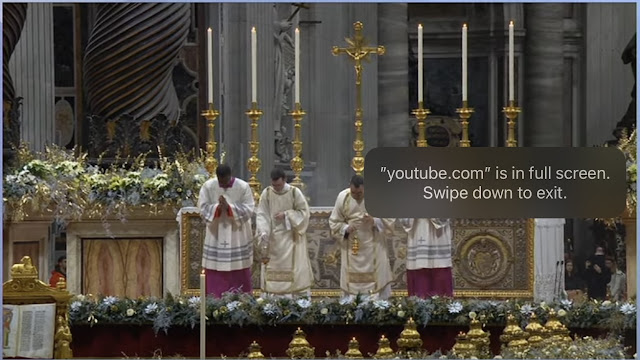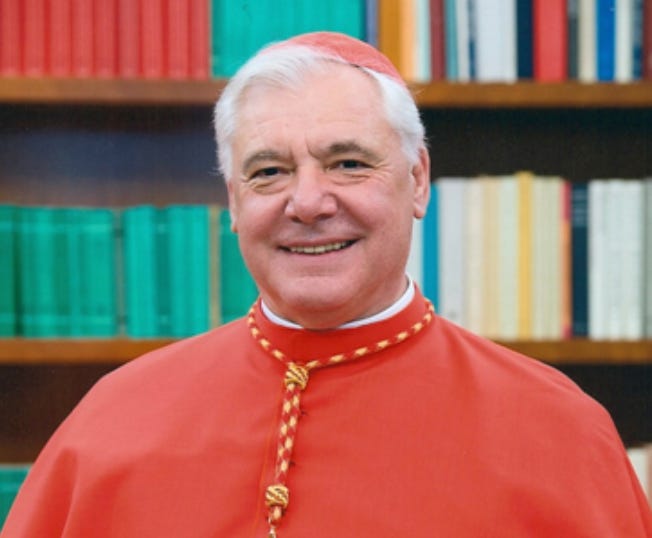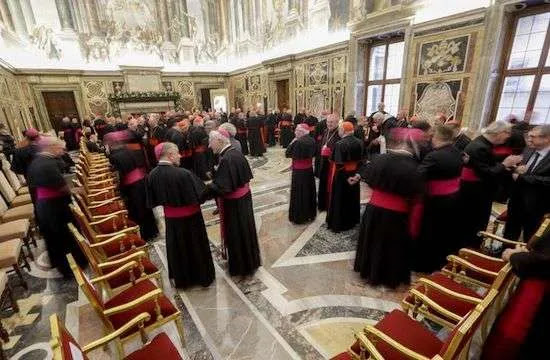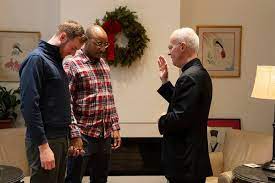Cardinal Becciu's jail sentence stuns Roman Curia
Some Vatican officials see the conviction of their former high-ranking confrère Angelo Becciu to be the act of an authoritarian pope
By Loup Besmond de Senneville | Vatican City
December 21, 2023
Cardinals and bishops await Francis at the Vatican, before his annual wishes to the Curia, 2019. (Photo by ANDREW MEDICHINI / AP)
The French Embassy to the Holy See held a reception on the evening of September 24, 2020 that, typical of ecclesial life in Rome, brought together foreign diplomats, journalists and members of the Roman Curia.
Then, just after 8 pm, a murmur ran through the gathering. People began pulling out their cell phones and, one-by-one, the screens all displayed the same news: Pope Francis had just dismissed Cardinal Angelo Becciu from his post as prefect of the Dicastery for the Causes of Saints and stripped him of all his privileges as a cardinal.
In the hushed atmosphere of Villa Bonaparte, disbelief was absolute. And now, three years later, after the cardinal was sentenced on December 17 to five and a half years in prison for fraud and embezzlement, it is clear that this impression has never really dissipated.
Indeed, the sentence the Vatican tribunal handed down last Saturday has triggered what some Church officials call "shock waves" throughout the Curia.
"I didn't expect such a decision," said one of them who had instead expected a "symbolic" condemnation.
On the eve of the verdict, few Curia officials could have imagined that a cardinal would be put behind bars, even though the Holy See's former Number 3 remains free while he appeals the verdict.
"Sacrificed as an example"
Of course, it's difficult to paint a true picture of the Vatican in just a few lines, a highly complex place where 3,000 people work in its various offices. Most of them are bound by the pontifical secret, a rule that was imposed on them as soon as they signed their contracts. Few are willing to talk. But within the Secretariat of State, even among priests who feel close to Francis, the sentence Becciu received has not gone down well.
"He seems to have been sacrificed for the sake of being made an example," said one of them.
The same official also expressed regret that "the Vatican's failings have been exposed to the public eye". While condemning the misappropriation of funds, he deplored the publicity that surrounded the trial.
"People have discovered that St. Peter's money could be used to buy palaces in London. It's catastrophic for the Church's image," he added.
The fact remains that this priest, like other sources interviewed by La Croix, "didn't follow much" of the 600 hours and 86 hearings of the interminable trial, during which Vatican magistrates tried to untangle the threads of a case of bad real estate investment.
Reawakening longstanding criticism
Of course, Francis also has his supporters, including those at the top of the hierarchy, such as this senior official who says he now expects the pope to draw the consequences of the Vatican court's judgment by removing Angelo Becciu from the College of Cardinals.
"What sense would it have made to condemn him to a one-year sentence after such a trial, which lasted two and a half years?" wondered an official of another Vatican dicastery.
In fact, beyond the cardinal's case, the sentence has reawakened long-standing criticism within the curial apparatus against a pope deemed to be too authoritarian. The judges' decision is just another sign of this.
"It's the last straw," lamented a veteran employee of one of the dicasteries.
Many see the severe sentence that was handed down to Becciu as yet another sign of the Argentine pope's desire to weaken the Roman Curia, like a dentist doing a root canal.
"Apart from his diplomats, he trusts no one," said one of his regular visitors a few months ago.
It's true that Francis has constantly bypassed his Vatican aides since the beginning of his pontificate and has relied on an outside parallel network of friends and advisors.
For instance, Cardinal Victor Manuel Fernandez, who just came to Rome this past September to head the Dicastery for the Doctrine of the Faith, was for many years one of the pope's unofficial ghostwriters. And the pope uses Cardinal Gianfranco Ghirlanda, a fellow Jesuit, to edit many of his motu proprios.
The latest example of this is the recent apostolic exhortation on the environment, Laudate Deum, which was never submitted to review by the Secretariat of State before its publication. That was a circumvention that left its officials deeply stunned and dismayed. Such practices not only provoke criticism, but also a kind of listlessness.
"A lot of people feel a bit lost," said an old Curia hand. "They've stopped doing their work. And they're waiting for what comes next."
Read more at: https://international.la-croix.com/news/religion/cardinal-beccius-jail-sentence-stuns-roman-curia/18897?utm_source=newsletter&utm_medium=email&utm_campaign=Mailjet_22Dec23N1&cmid=fb7cc1ae-a8a8-4295-a91e-93f71ab628cf


















































